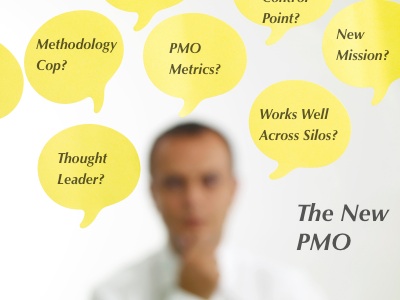 The Program Management Office (PMO) function became common in the late 1990s as companies were launching projects to prepare for Y2K challenges. These PMOs had the mission of coordinating and sometimes controlling these myriad Y2K initiatives. These PMOs carried out their missions and moved on to additional challenges such as SOX, large-scale accounting, CRM, and ERP implementations. They have established themselves as the “go-to” source for project management information and are often positioned as the gatekeeper for all enterprise-level projects. There has been a continuous flow of projects through these PMOs and they have become a key part of the corporate landscape.
The Program Management Office (PMO) function became common in the late 1990s as companies were launching projects to prepare for Y2K challenges. These PMOs had the mission of coordinating and sometimes controlling these myriad Y2K initiatives. These PMOs carried out their missions and moved on to additional challenges such as SOX, large-scale accounting, CRM, and ERP implementations. They have established themselves as the “go-to” source for project management information and are often positioned as the gatekeeper for all enterprise-level projects. There has been a continuous flow of projects through these PMOs and they have become a key part of the corporate landscape.
As the PMO function became firmly established, along came the agile movement. The agile principles, which feature short delivery cycles, frequent business-driven prioritization, and a bias toward results over paperwork, offers a solution for businesses that need to adapt to a dynamic and hostile business environment. The early agile initiatives, circa 2004-2010, were undertaken as pilot projects. In the past 2-3 years, the pilot projects have given way to efforts to scale agile to an enterprise level. Soon agile will be the de facto framework for software development projects.
Regardless of the particular approach to agility (Lean, Scrum, XP, Scaled Agile, Disciplined Agile, etc.) agile at scale will drive significant changes in the manner in which projects are planned and executed. There will be a transition from command and control culture toward servant leadership and empowerment. This will, in turn, spawn more self-managed teams with new roles and greater accountability. These teams will deliver projects in shorter timelines with a reduced need for extensive oversight and control measures. As agile drives changes to project delivery, the PMO must change accordingly and this will require starting with a blank sheet of paper.
If they have not already done so, PMO leaders need to rethink their strategic plans. They should begin by talking with key stakeholders to understand their perception of the business value provided by the PMO.
-
Do stakeholders view the PMO as only a “methodology cop” or control point?
-
Is the PMO viewed as the owner of plans or an enabler of business results?
-
Do the current PMO prioritization methods ensure the highest value work is being undertaken?
-
Do PMO metrics provide information to support effective decision-making by senior management?
-
Which PMO activities are contributing to the realization of business value, and which activities are impediments?
The PMO leader should re-evaluate the PMO’s mission and vision in light of these conversations. From the viewpoint of these key stakeholders, has the purpose of the PMO already changed? What unique business value can be provided by the PMO in light of these changes? Given the updated mission, the PMO leader should consider the following:
-
Why should key stakeholders and PMO staff embrace this change?
-
To what extent will legacy mindsets impede the transformation to a new mission?
-
What actions will be required to establish the PMO as a credible thought-leader in support of the new mission?
-
What services should be discontinued and what new, higher value services be launched?
-
How will the PMO acquire the resources to make these changes, given current workloads?
-
What project control processes should be replaced or eliminated?
-
What metrics are no longer useful and what new metrics should be captured?
-
Will the PMO need to support additional stakeholders?
-
How can the PMO enable collaboration across business and technology silos?
-
How will the PMO interact with new roles such as product owner and scrum-master?
PMOs have successfully carried out their missions for the past 10-15 years. However, while past success can buy some useful political capital, it does not guarantee future success. Therefore, the PMO leader should develop a new strategic plan and then obtain executive sponsorship for a program to transform the PMO into an organization that continues to add business value as the agile movement continues to mature.
Additional Resources:
Following is a link to a helpful book on setting up a PMO that provides significant business value. I particularly like the way the author distinguishes between PMOs that add business value vs. PMOs that seem to be implemented by project managers and for project managers.
www.botinternational.com/business_driven_pmo_setup.htm
Following is a link to the Scaled Agile Framework (SAFe) which has been employed at many large-scale enterprises. It focuses on three levels: portfolio, program and team. In reviewing this framework, a PMO leader can identify previously overlooked opportunities to add value in a large-scale agile environment.
www.scaledagileframework.com

Written by Ron Montgomery, Management Consultant & Owner, OnPoint, LLC Ron is certified as a Project Management Professional, Agile Certified Practitioner and Certified ScrumMaster with over 35 years of hands-on experience in business planning, software development, process improvement & deployment of software solutions. By partnering with clients to drive business value from technology projects, Ron assists clients with business planning, IT strategy, project and program management, vendor selection and team training/mentoring.
Did you find this article informative? Let us keep you up-to-date on all of our training articles. Please sign up for our newsletter today!
Here are some related articles you may be interested in:
Communication Essentials For Project Managers
Creating An Agile Culture: Top 3 Challenges Empowered Teams Face
Learn How Action Oriented Team Management Can Drive Timely Results.
Lessons Learned Templates & Guide: A Managers Toolkit for Continuous Improvement
Agile Methodology: A Creative Approach to Project Management
Agile Success Factors: The Product Owner Role
Operating Systems Assessment
At ManagingAmericans.com we customize organizational tools that discover & unlock the true potential of individuals and organizations. Our focus is to align objectives, engage people & link strategy to execution. We support that effort with 30+ Expert Consultants providing exclusive management & leadership training & management consultancy services in one easy to use location.